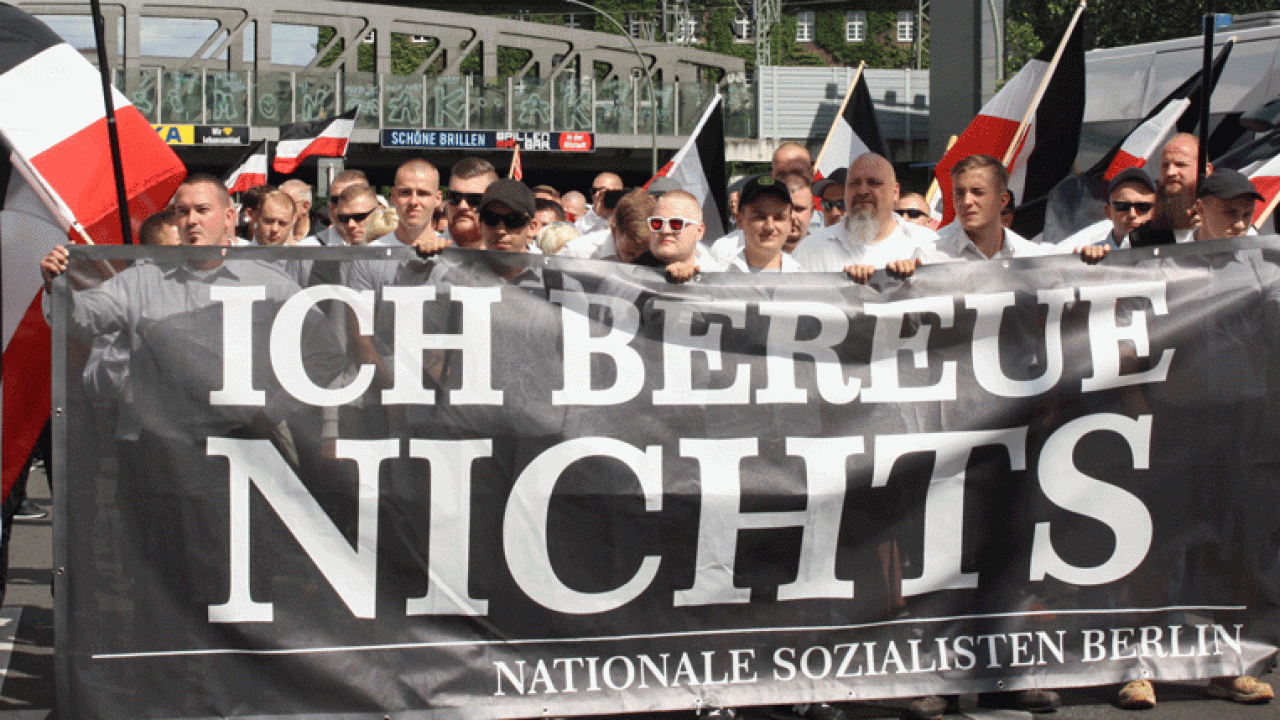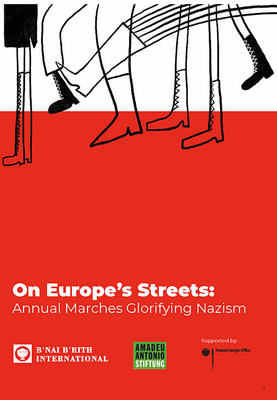
This text is an excerpt of the broschure „On Europe’s Streets – Annual Marches Glorifying Nazism“ by B’nai B’rith and Amadeu Antonio Foundation.

This text is an excerpt of the broschure „On Europe’s Streets – Annual Marches Glorifying Nazism“ by B’nai B’rith and Amadeu Antonio Foundation.
Location: Wunsiedel, Berlin, and other German cities
Date: 17. August
The Rudolf Heß Memorial March serves as a hero’s memorial (Heldengedenken) for the Nazi war criminal Rudolf Heß. Heß was Obergruppenführer of the SS in Nazi Germany and served as Deputy Führer of the Nazi Party (NSDAP). Amongother things, he was responsible for theformulation of the Nuremberg Race Laws,which disenfranchised Jews in Germany andallowed for their persecution.In 1941, Heß flew to the United Kingdom tomeet a group of politicians he saw as opponents to Winston Churchill. Instead, he wasarrested, and his flight was regarded as a betrayal by the Nazi government, and Heß wasdeclared insane. At the Nuremberg Trials in1945, he was sentenced to life imprisonmentas one of 24 major war criminals. He showedno remorse at trial or in custody, famouslysaying “I regret nothing” as his last words incourt. Heß committed suicide in 1987, hanging himself with an extension cord in the warcrimes prison in Berlin’s Spandau district,whose sole inmate he had been since 1966. After his death, the prison was demolishedso that it would not become a pilgrimagesite. At his own request, Heß was buried inhis parents’ grave in the town of Wunsiedel, in the state of Bavaria, which in turn became a neo-Nazi pilgrimage site.
The first annual march in honor of Heß was held in 1988 in Wunsiedel, attracting around 120 neo-Nazi “mourners.” After the town banned the march in 1991, it moved to other German cities, such as Rudolstadt in 1992, and eventually abroad to Luxembourg in 1994, Roskilde in Denmark in 1995, Trollhättan in Sweden in 1997, and Grewe in Denmark in 1998. No march took place in 2000. In 2001, neo-Nazi lawyer Jürgen Rieger was able to overturn the ban in Wunsiedel. Subsequently, annual marches took place there again between 2001 and 2004. In 2005, the march was banned again, which was confirmed in court in 2009. Nonetheless, there were still smaller, isolated memorial events in other German towns and cities. In 2009, when Rieger died, neo-Nazis registered a memorial march for him in Wunsiedel instead, attracting 850 participants. In 2011, Heß’ gravesite in Wunsiedel was removed with the consent of his heirs. His remains were exhumed, burned, and buried at sea. That year, only 20 neo-Nazis embarked upon the annual pilgrimage, spelling an end to the era of sizeable Heß marches there. From 2009, demonstrations were no longer allowed to explicitly refer to Heß, yet they continued under various pretenses, rife with allusions to National Socialism. Between 2012 and 2014, these marches attracted around 200 participants.
On the 30th anniversary of Heß’ death, in 2017,800 extremists marched through Spandau displaying a banner with Heß’ infamous last words, “I regret nothing.” Yet this was not regarded by the authorities as a direct reference to Heß. In 2018, 700 people attended a demonstration in Berlin. In 2019, there was again a “hero’s memorial” in Wunsiedel, organized by Der III. Weg, with a parallel memorial event in Schleusingen, Thuringia. The COVID-19 pandemic prevented any demonstrations in 2020. Demonstrations were registered in 2021 and 2022 by Der III. Weg in Wunsiedel, drawing very small crowds.
The first Heß marches in Wunsiedel were organized by neo-Nazis linked to Christian Worch and Michael Kühnen. The latter formulated the goal of never letting Wunsiedel “come to rest” again. Later, other neo-Nazis such as Andreas Rachhausen, Thomas Dienel and Tino Brandt became organizers. Between 2001 and 2009, demonstrations were registered by Rieger. Since 2015, Der III. Weg has organized demonstrations in Wunsiedel.
The first march in Wunsiedel in 1988 counted 120 participants. Peak numbers were reached in 2004 with
3,800 participants. Numbers have dwindled considerably in recent years, with the 2021 march counting only 150 participants, and 120 for a November 2022 gathering.
Throughout the years, the various manifestations of the annual Heß Memorial March have attracted Nazis old and new. Specifically, many active members of the Blood and Honour network have participated, as well as German far-right parties NPD, DVU, Der III. Weg and Die Rechte. The son of Rudolf Heß,
Wolf Rüdiger Heß, campaigned throughout his life for his father’s release and rehabilitation. In 1967, he founded the Hilfsgemeinschaft Freiheit für Rudolf Heß e.V. (HFRH), which claimed to have 2,000 members and drew international attention to the march.
The myth of Rudolf Heß as the only high Nazi functionary whose grave site could be visited, fascinated neo-Nazis internationally. Already in 1989, international visitors from Belgium, Denmark and Austria attended, including Bert Eriksson, founder of the Vlaamse Militanten Orde (VMO). In 1991, the English translation of Wolf Rüdiger Heß’ book about his father was published by Canadian Holocaust denier Ernst Zündel, who had good contacts with other Holocaust deniers across the globe, such as Spain’s Pedro Varela and the
UK’s David Irving. All three campaigned for the march for the first time in 1991, and Irving was a keynote speaker in the same year.
Other neo-Nazis have promoted the march in Wunsiedel, including Povl Riis-Knudsen (World Union of National Socialists/WUNS), Claude Cornilleau (Parti nationaliste français et européen/PFNE), and Christian Ruiz (Círculo Español de Amigos de Europa/ CEDADE). In 1991, Around 250 of the approximately 2,000 neo-Nazis at the march hailed from neighboring European countries. In 1993, neo-Nazis from Denmark’s Nationalsocialistiske Bevægelse, and from the Swedish terrorist organization Vitt Ariskt Motstånd, took part in the demonstration. The Rudolf Heß Memorial March became a fixture in the international neo-Nazi calendar, and an important networking event.
As the marches grew larger in 2002, so did international participation from across Europe. While international participation peaked in 2004 and has decreased significantly since 2007, the networks established at the marches remain active.
Previous iterations of the march have included large contingents of violent neo-Nazis, belonging to illegal, and sometimes terrorist organizations. Violent confrontations between neo-Nazis and counterdemonstra-
tors in 1990 led to a ban between 1991 and 2000. The members of the National Socialist Underground (NSU), who carried out a wave of terrorist murders and bombings between 2000 and 2006, attended the march in the early 1990s.
The march focuses primarily on the glorification of National Socialism and the rehabilitation of Nazi war criminal Rudolf Hess. Holocaust deniers have promoted, attended and addressed the marches. However, overt antisemitic references are uncommon.
From its inception, the Hess Memorial March was met with counterdemonstrations. Early on, clashes
between neo-Nazis and counterdemonstrators were regarded by the authorities as the threat to public order, and not the march itself. When in 2001, marches were again officially allowed, the citizens of Wunsiedel organized large counterdemonstrations. In 2011, the Protestant church of Wunsiedel terminated the lease on Hess’ grave, leading to the above-mentioned removal. The most spectacular counterdemonstration took place in 2014: The citizens’ initiative Wunsiedel is colorful (Wunsiedel ist bunt) turned the event, which had been registered by Der III. Weg, into a “fundraising run”, under the motto Recht gegen Rechts (The rule of law against the far-right). For every meter covered by the far-right procession, 10 euros were donated to the Exit organization, which helps neo-Nazis to leave the scene.
Between 1988 and 1990, stationary rallies were allowed. From 1991 to 2000, they were banned, but still took place – in Wunsiedel and other German cities, and abroad. From 2001, demonstrations in Wunsiedel were allowed again, as confirmed by the Federal Constitutional Court, Germany’s Supreme Court. Thanks to an amendment criminalizing the endorsement, justification, or glorification of National Socialist rule, the marches were banned again in 2005. Legal action was taken again all the way to the Federal Constitutional Court, which this time upheld the ban.
On the 20th anniversary of Hess’ death in 2007, pre-emptive bans on demonstrations were put in place in numerous German cities. Nevertheless, some demonstrations still went ahead.[152] In 2009, the Federal Constitutional Court handed down the so-called Wunsiedel decision, which finally confirmed the ban on the marches, relying on an amendment criminalizing incitement (Volksverhetzung). Nevertheless, far-right
groups have continued to register demonstrations on other (bogus) topics.

The report is available to download (in English):
Klicken Sie auf den unteren Button, um den Inhalt von www.amadeu-antonio-stiftung.de zu laden.
Excerpts from the report on Belltower.News:
Part 1: The Marches
1. Day of Honor, Hungary
2. Memorial March for the Bombing of Dresden, Germany
3. Lukov March, Bulgaria
4. Blue Division March, Spain
5. Remembrance Day of the Latvian Legionnaires
6. Bleiburg Meeting, Austria
7. Rudolf Hess Memorial March, Germany
8. Iron Wake, Belgium
9. March on Rome, Italy
10. Independence March, Poland
11. Kohti vapautta and 612-march, Finland
12. Imia March, Greece
Conclusion to Part I: The danger of the marches (available also in German)
Part 2- Legal Analysis
„Der III. Weg“ wird immer aktiver in Berlin-Neukölln: Durch Flyeraktionen und provokative „Kiezspaziergänge“ fällt die neonazistische Kleinstpartei auf. Dieser Aktionismus ist unter anderem dem vorbestraften Neonazi Sebastian T. zu verdanken, einem Hauptverdächtigen in der rechtsextremen Anschlagsserie im Bezirk.
Am kommenden Samstag wollen bis zu 1.000 Neonazis durch Spandau marschieren. Anlass ist der 30. Todestag des Hitler-Stellvertreters Rudolf Heß. Die Kundgebung hat das Potential die bundesweit zerstrittene Szene einen zu können. Doch viele zivilgesellschaftliche Organisationen wollen verhindern, dass die Rechtsextremen ungestört durch Berlin laufen und rufen ab 11.00 Uhr zum Gegenprotest auf.
Am Samstag sind Neonazis in Berlin-Spandau zum Gedenken an den NS-Verbrecher Rudolf Heß aufmarschiert. Ihre geplante Strecke konnten sie zwar dank engagierter Gegendemonstrant_innen nicht erreichen, dieser Erfolg sollte jedoch nicht verschleiern, dass die rechtsextreme Szene trotz heftiger interner Zerstrittenheit insgesamt 1.100 Neonazis mobilisieren konnte – aus dem In- und Ausland.